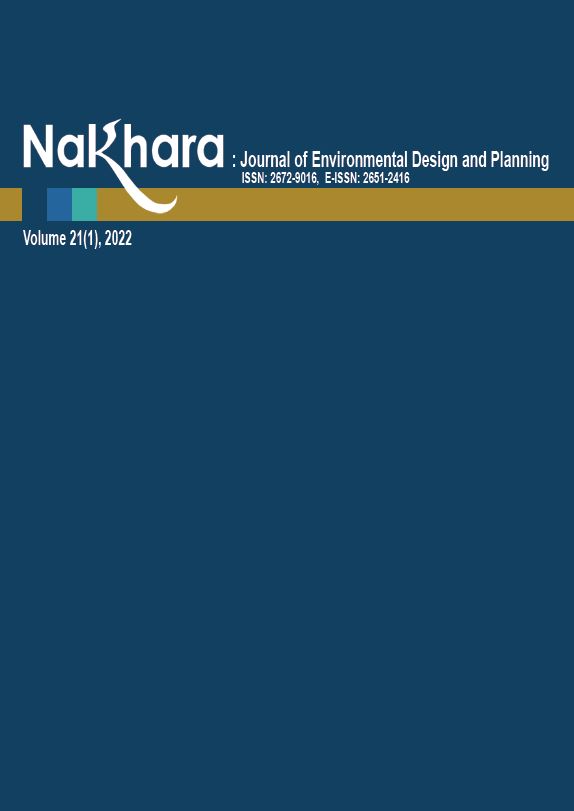Curartistry: Curating Everyday Artistry in Bangkok
Main Article Content
Abstract
How can architecture be taught internationally, beyond the neocolonialist tendency of European-based international exchange programs? Curartistry, a method of curating everyday artistry in Bangkok, is used to achieve bilateral exchanges in art and architectural education between teachers and students of different nationalities. We offer interpretations of late-nineteenth-century and post-war ideas of “everyday life,” based especially on Charles Baudelaire’s “The Painter of Modern Life,” Henry Lefebvre’s “Critique of Everyday Life,” Maurice Blanchot and Susan Hanson’s “Everyday Speech,” and Walter Benjamin’s “On Some Motifs in Baudelaire.” Their ideas grew out of their experiences in Western European metropolises, and continue to reflect similar conditions in twenty-first-century Bangkok. In addition to these literary works, Henry W. Lawrence’s City Trees: A Historical Geography from the Renaissance through the Nineteenth Century has been useful in the development of our workshop entitled, “Curartistry: Trees in Bangkok.”
Curartistry is a practice in which particular elements of a city are researched and recorded in drawing and photography. We invite students to visit overlooked sites, landscapes, and trees in Bangkok, and then to write and rewrite until a particular object or installation emerges from redrafting their experiences. These records lead to the proposal of projects, whether artistically, architecturally or otherwise crafted. Once a proposal takes on the form of a project, its existence as a project, rather than as a finished artwork or artefact, is what lends the project criteria for judging it. Outcomes from these projects typically take the form of an elementary installation or exhibition, presented by individual students to guest critics.
In this article, we discuss the processes of work, and how everyday artistry in Bangkok is curated in relation to the selected ideas of “everyday life” that transcend time and place, as well as the construction of our method of work. Curartistry is a key way in which we are addressing fundamental issues of city life such as social inequality, nature, ecological crises, labour, and materiality. The final outcomes often address a number of issues, such as the intense relationship between nature and city, dramatic effects in light and colour, transplantation, or tree names in relation to Thai beliefs in fortune. It is hoped that this attempt to systematically document the subjective experiences of urban life will be read as a contribution to global architectural education.
Article Details

This work is licensed under a Creative Commons Attribution-NonCommercial-NoDerivatives 4.0 International License.
References
Askew, M. (2002). Bangkok: Place practice and representation. Routledge.
Baudelaire, C. (1964). The painter of modern life and other essays. Phaidon Press. (Original work published 1863).
Benjamin, W. (1999). On some motifs in Baudelaire. In H. Arendt (Ed.), Illuminations (pp. 152-196). Pimlico.
Bhuyan, B. & Sonowal, R. (2021). An overview of Pandanus amaryllifolius Roxb.exLindl. and its potential impact on health. Current Trends in Pharmaceutical Research, 8(1), 138-157.
Blanchot, M. (1987). Everyday speech (S. Hanson, Trans.) Yale French Studies, (73), 12–20. (Original work published 1959).
Grant, N. (2003). Everyday life in ancient Rome (uncovering history). British Museum Press.
Hoffman, E.T.A. (1816). The sandman. Eastern Illinois University. https://www.ux1.eiu.edu/~rlbeebe/sandman.pdf
Lawrence, H.W. (2006). City trees: A historical geography from the renaissance through the nineteenth century. University of Virginia Press.
Lefebvre, H. (2014). Critique of Everyday Life. Verso.
Naktamna, A. (with Kathmandu Photo Gallery). (2016). Signs. Self Publishing.
Narula, R. (with Breyer, M.). (2016). Platform 10. Peanut Press.
Proust, M. (2003). The Way by Swann’s (L. Davis, Trans.). Penguin Classics. (Original work published 1913).
Seeumpornroj, P. (2021). Globality in teaching art and architectural history: A case study of the glossary assignment. Nakhara: Journal of Environmental Design and Planning, 20(2), Article 109. https://doi.org/10.54028/NJ202120109
Sheringham, M. (2006). Everyday life: Theories and practices from surrealism to the present. Oxford University Press.

